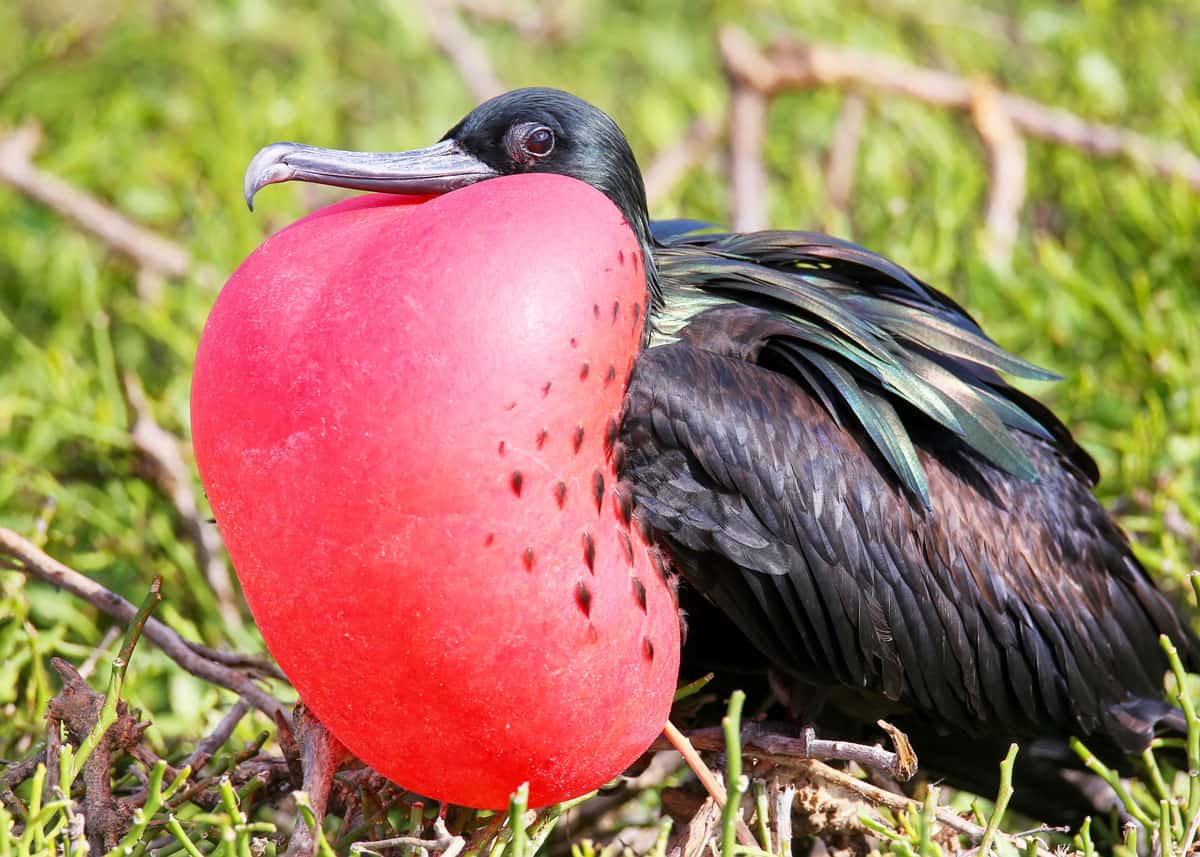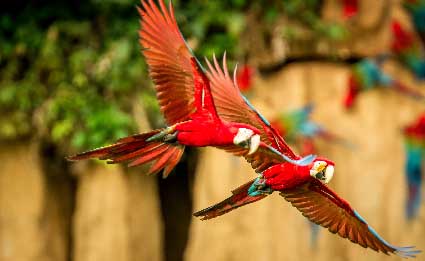Do you want to learn about the magnificent frigatebirds in the Galapagos? In this post, you will learn 15 amazing facts about these super cool birds found in the Galapagos Islands.

Learn about other Galapagos birds
15 Facts About Magnificent Frigatebirds in the Galapagos
Magnificent frigatebirds live up to their names: magnificent! These birds are truly striking: big, black, and powerful, they make quite a silhouette when flying.
You have very good odds of seeing a magnificent frigatebird on your next Galapagos adventure because they like to fish near land.
Read on to learn more about these amazing birds!
1. Magnificent Frigatebirds can’t land on the ocean
Even though magnificent frigatebirds are seabirds, their feathers aren’t waterproof. Because of this, they can’t land on the ocean. If they did, the water would make them very heavy and they wouldn’t be able to take off, which means that they would eventually drown.
Their legs and feet are very small, so they can’t paddle well with them; they rarely even walk!
2. They have a fishy diet
Being seabirds, it makes sense that the magnificent frigatebird feed mainly on fish, crustaceans, jellyfish, and squid. Magnificent frigatebirds like to feed close to shore, so you have a very good chance of seeing them!
3. They are thieves
Magnificent frigatebirds practice kleptoparasitism, this is a practice that involves stealing the food (fish and squid) from other seabirds, like blue-footed boobies.
While it can be quite amusing to watch, you can’t help but feel kind of sorry for the poor booby; frigatebirds take hold of their tail feathers and shake them violently until they give up their catch.
Watch on YouTube
4. They have specialized beaks
Magnificent frigatebirds have long, thin, hooked beak that is specially designed to help them catch – and steal – slippery fish.
5. They look like they’re ready for a party
When a male magnificent frigatebird blows up that big balloon on its neck, it looks like it’s ready to go to a party! That balloon is actually called a gular sac and it takes them about 20 minutes for him to inflate. They use it to attract a mate in the mating season which can be all year round in the Galapagos and can vary between islands.
6. They sound pretty amazing
Magnificent frigatebirds make a drumming, rattling, clacking type noise that is very interesting and different from most birds that I’ve heard. Check out the video below to hear them!
Watch on YouTube
7. Magnificent Frigatebirds have fascinating colors
Magnificent frigatebirds are mainly black, but they have a beautiful purple sheen on their black feathers – this makes them easily distinguished from great frigatebirds, who have a striking green sheen.
The male has an amazing red gular sac which he uses to attract a female, who has a white patch on her chest instead of a gular sac. Female magnificent frigatebirds have a blue ring around their eyes.
8. They have a fitting name
French mariners called frigatebirds “La Fregate,” like the old warships of the 17th and 19th centuries. The English mariners called the frigatebirds’ Man-of-War birds, but the French mariners’ name stuck. “Frigatebird” is derived from the French “la fregate.”
The name is fitting as the frigates which the birds are named after were fast, maneuverable, and effective vessels. The frigatebird is built for speed and, thanks to there forked tail, they can maneuver easily in the air. Their hooked beak makes them wonderfully effective at fishing and kleptoparasitism.
In Spanish, magnificent frigatebirds are known as “rabihorcado,” meaning “forked tail,” which comes from their deeply forked tail that they use for steering.
9. They are well traveled
Magnificent frigatebirds are found nesting in the Galapagos and the coast of Ecuador down to Mexico and in the Caribbean and Florida. Some small colonies have been found in Denmark, BC, Spain, the Isle of Man, and England.
10. They are monogamous
Male magnificent frigatebirds are monogamous, which means they only mate once per season.
11. It takes 13 days to build their nest
Female magnificent frigatebirds build their nests on top of small shrubs, bushes, or low trees. The males sit on one of these low plants and court the females. The female then builds the nest on the display perch of the male of her choosing.
The male brings her sticks that he has gathered – and stolen from other frigatebirds – to build their nest. She will then build a nest about 1 ft (0.3 m) wide, which takes around 13 days.

12. It takes a long time to raise the young
The mother magnificent frigatebird lays up to 2 white eggs, and both parents care for and feed them for about 3 months. After, the male leaves the female to raise the chick alone for about 1 year.
13. Males mate every year, females mate every 2 years
Because the males only stays with the females for roughly 3 months, it frees him up to mate again next year. But the female stays to take care of the chick(s) so she can only mate every other year.
14. They are the largest frigatebirds in the world
Magnificent frigatebirds can grow up to 3.7 ft (1.1 m) long and a wingspan of up to 8 ft (2.4 m) and weigh up to 3.5 lb (1.5 kg), making them the biggest frigatebird in the world! An average adult man is roughly only 5.9 ft (1.7 m) tall, meaning that a magnificent frigatebird can have a wingspan 2 ft (0.6 m) longer than a man is tall. That is one impressive bird!

15. They live for a long time
There isn’t a ton of data on exactly how long magnificent frigatebirds live, but a good estimate of lifespan should be around 30 years.
Explore Our Birding Watching Tours

Birds of the Ecuadorian Amazon
Explore the amazing biodiversity of the Amazon Rainforest accompanied by a bird specialist guide

Birding at the Tumbesian Region
The Tumbesian lowlands are considered as an Endemic Bird Area by BirdLife International.

Birding at the Choco Cloud Forest and Andes Slopes
Ecuador’s Choco lowlands has the greatest concentration of restricted range endemic species in the world.
Ecuador Phone: (593) 2-3801125 / 2-3801149 Email: info@latinrootstravel.com Skype: latinrootstravel.ecuador Latin Roots Travel Av del Establo y Calle E, Centro Corporativo Financiero Site Center, Torre 3, Oficina 107, Quito – Ecuador
Powered by Auveron Studio


